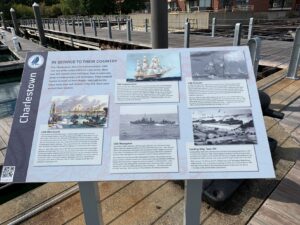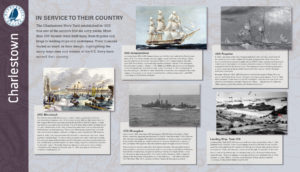In Service to Their Country
in Charlestown
The Charlestown Navy Yard established in 1800 was one of the nation’s first six navy yards. More than 200 vessels were built here, from frigates and brigs to landing ships and destroyers. Their missions varied as much as their design, highlighting the many ways men and women of the U.S. Navy have served their country.
Among the ships built at the Charlestown Navy Yard:
USS Independence
Launched June 1814, USS Independence was the first ship built at the Charlestown Navy Yard. This three-masted, square-rigged vessel with two covered gun decks was the battleship of that era. During the War of 1812, Independence, together with USS Constitution, protected approaches to Boston Harbor. Then she spent 20 quiet years docked in Boston. In the 1830s and 1840s, she served as the flagship of several squadrons, sailing to Europe, Russia and Chile. In 1857, Independence was docked again, this time at Mare Island Navy Yard. She was stripped of her sails, rigging, and cannon, to serve as a receiving ship—a floating barracks—until 1912.
USS Porpoise
In 1836, two years after USS Porpoise was built here, the brig sailed around the world as part of the notable U.S. Exploring Expedition. Over four years, the six-vessel naval squadron sailed almost 87,000 miles, explored and surveyed 1,500 miles of the Antarctic continent, charted hundreds of Pacific islands, and mapped the Pacific Northwest coast. The squadron returned bearing thousands of specimens and artifacts, which helped form the basis of the Smithsonian Institution’s collections.
Between 1843 and 1851, USS Porpoise served off the coast of West Africa as part of the African Slave Patrol—charged with intercepting slavers. Then in 1854, while assigned to her second scientific expedition, Porpoise was lost at sea with all hands, somewhere between Taiwan and China.
USS Merrimack
The 275-foot-long USS Merrimack—a hybrid frigate, powered by sails and coal-fired steam engines—slid off the ways here in 1855. Six years later when the Civil War began, Merrimack was stationed at Norfolk Navy Yard in Virginia—a state that had just seceded from the Union. The U.S. Navy feared their warship would fall into Confederate hands. They ordered the Merrimack burned and scuttled. Confederates needed warships. They raised Merrimack, covered her hull with four-inch-thick iron plates, removed all rigging, and renamed her CSS Virginia.
March 9, 1862, CSS Virginia faced USS Monitor in the world’s first naval battle between ironclad ships. For hours, they pounded each other with cannon balls. The armored plates deflected them all. With the battle a tie, the ironclads withdrew. Two months later, to avoid capture by Union troops, Virginia’s commander ordered her burned—again. The battle, however, signaled a new era in naval warfare.
USS Monaghan
Launched in 1935, destroyer USS Monaghan was stationed at Pearl Harbor when the Japanese attacked the U.S. Pacific Fleet December 7, 1941. Minutes after the bombing began, Monaghan was searching for enemy midget submarines in the harbor. The destroyer tried to ram one of the subs, which fired a torpedo at her but missed. Monaghan’s crew dropped two depth charges and sank the sub.
Anti-submarine warfare was often Monaghan’s mission. She guarded carriers and provided a protective screen from enemy subs at the pivotal Battle of Midway. Despite the extraordinary danger the destroyer faced in multiple battles, it was not the enemy that destroyed her. One week before Christmas 1944, a typhoon capsized the destroyer, killing all but six crew members.
Landing Ship, Tank–310
Landing Ship, Tank (LST)–310 was one of 46 built here during World War II. LSTs enabled beach assaults. Their unique design included a flat keel as well as twin propellers and rudders so the vessel could ride up on a beach, stay upright, but not run aground. Tanks, vehicles, and troops exited through a huge door in the bow.
With a crew of 14 officers and 131 enlisted men, LST–310 helped Allied forces retake Europe—first in amphibious landings on Sicily and mainland Italy in 1943, and later in June 1944 on the Normandy beaches: D-Day (pictured above).
Sign Location

More …
Resources
- A description of a captured slaving ship https://www.newenglandhistoricalsociety.com/nightingale-boston-last-gasps-american-slave-trade/
- for more about the interception of slavers https://scholarworks.umass.edu/cgi/viewcontent.cgi?article=1127&context=cibs
- General U.S. Navy vessel info
Acknowledgments
- Warm thanks to National Park Service historian Steve Carlson for his input and review.
- Thank you to Mike Manning for all his enthusiastic work on famous Charlestown Navy Yard-built vessels.
- Our deep gratitude to Ann and Chuck Legasse for their enthusiasm and commitment to celebrating the former Navy Yard’s history.

